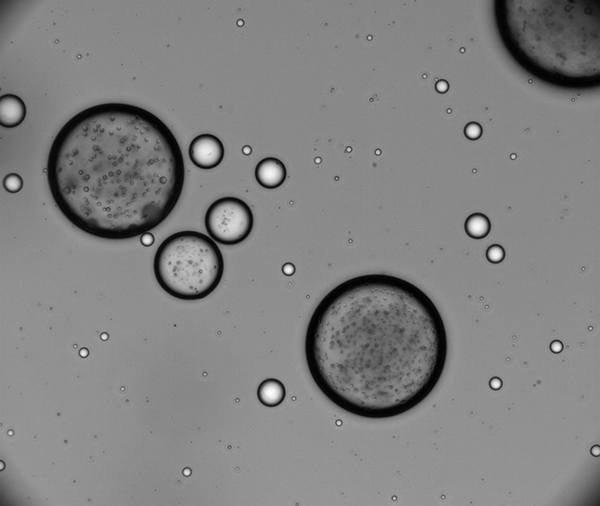How the cells that make up all of extant life came to being on ancient Earth is still a significant mystery. Although modern cells have membranes, it is plausible that primitive cells, i.e., protocells, did not. Thus, the author comments about two primitive membraneless compartment systems, coacervates and polyester microdroplets, that may shed light on the origin of cells. This commentary resulted from the Biophysical Reviews 2023 Michèle Auger Award for Young Scientists’ Independent Research, which the author was shortlisted for.

There are a number of different compartment systems used by origins of life researchers that shed light on different aspects of the origins of modern cells. For example, lipid bilayer membrane vesicles are the protocell models closest to modern cells in terms of structure. However, before the advent of membranes, could a different type of membraneless protocell have been present on early Earth that significantly contributed to the origins of life? This topic is what drives the research of Specially Appointed Associate Professor Tony Z. Jia of the Earth-Life Science Institute (ELSI) at Tokyo Institute of Technology, leading to the published commentary, which was a result of the Biophysical Reviews 2023 Michèle Auger Award for Young Scientists’ Independent Research that Jia was shortlisted for.
In this commentary, Jia describes two types of primitive membraneless compartment systems that his lab studies, each assembled from different modes of liquid-liquid phase separation (LLPS) (Image. 1): coacervates and polyester microdroplets. Coacervates are generally assembled through the binding of oppositely charged polyions, such as cationic peptides and nucleic acids, with negatively charged phosphate backbones, leading to associative LLPS. Polyester microdroplets are generally assembled by dehydration synthesis of alpha hydroxy acid monomers, followed by rehydration, leading to segregative LLPS.
With more than a decade of experience studying peptide-based coacervates, the recent systems Jia has been researching, in collaboration with Assistant Professor RTD/B Tommaso Fraccia of the University of Milano, involve binding of cationic polylysine peptides with short, palindromic DNA. These DNA in fact assemble into liquid crystals, and binding with coacervate-forming peptides resulted in the co-assembly of liquid crystal coacervates, a one-of-a-kind system with potential emergent catalytic and structural properties relevant for primitive systems.
The other type of system highlighted in this commentary, polyester microdroplets, was discovered and developed completely at ELSI, along with a number of collaborators previously or currently at ELSI, including Dr. Irena Mamajanov (Merck), Dr. H. James Cleaves II (Howard University), Dr. Kuhan Chandru (National University of Malaysia), Dr. Rehana Afrin (ELSI), Dr. Ruiqin Yi (ELSI), and Dr. Chen Chen (RIKEN Center for Sustainable Resource Science), among many others! The membraneless polyester microdroplets displayed the ability to segregate various small molecule dyes and biomolecules while simultaneously displaying the ability to uptake various salts. These functions are believed to be potentially relevant for the emergence and evolution of primitive chemical systems, and further study of functional polyester microdroplets could be the key to further understanding their role at the origins of life.
However, while Jia has elucidated some properties of these membraneless protocell systems, more types of systems and other novel properties are certainly yet to be discovered. In particular, one goal of the field may be to demonstrate evolvable membraneless protocell systems, which could go a long way toward understanding their contribution to primitive chemical evolution. Similarly, whether these membraneless protocell systems could have scaffolded assembly of membranes, leading to the first membrane-bound membraneless protocells, could be a key historical event leading membraneless systems to the first membrane-bound systems, eventually leading to the emergence of membrane-bound cells. Jia challenges the origins of life research field to further explore such difficult questions in our quest to understand the role of membraneless protocells at the origins of life.
Finally, as this commentary was part of the Biophysical Reviews 2023 Michèle Auger Award for Young Scientists’ Independent Research, congratulations are due to the winner, Associate Professor Antonio Benedetto of University College Dublin. Calls for nominations for the Biophysical Reviews 2024 Michèle Auger Award for Young Scientists’ Independent Research are also now open, and Jia challenges young biophysicists, especially those studying the origins of life, to raise their hand for this!

| Journal | Biophysical Reviews |
| Title of the paper | Primitive membraneless compartments as a window into the earliest cells |
| Authors | Tony Z. Jia1,2* |
| Affiliations | 1. Earth-Life Science Institute, Tokyo Institute of Technology, 2-12-1-IE-1 Ookayama, Meguro-Ku, Tokyo, 152-8550, Japan 2. Blue Marble Space Institute of Science, 600 1st Ave, Floor 1, Seattle, WA, 98104, USA |
| DOI | 10.1007/s12551-023-01135-9 |
| Online published date | 8 September 2023 |
